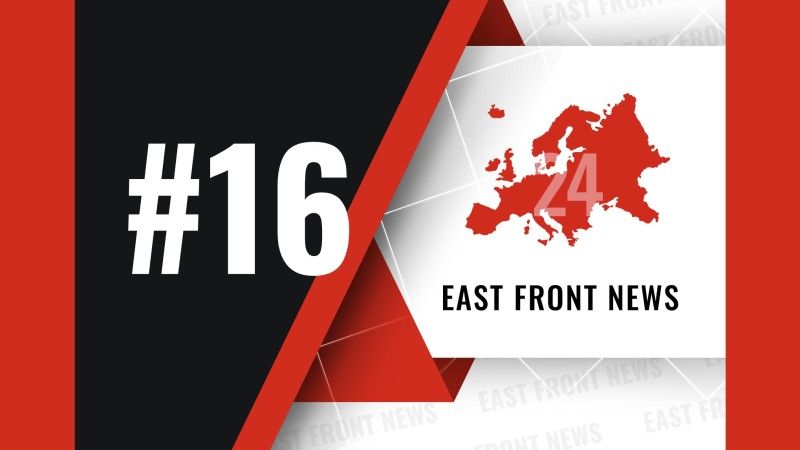East Front News #16: Polish Hospitals May Support NATO, Poland to Procure Precision Artillery; Ukrainian Victory Plan

East Front News is a weekly newsletter summarizing the past week’s most important events concerning security and the situation in the Central and Eastern Europe region. It includes original opinions and comments, along with key news items significant from a Polish perspective. If you would like to receive this newsletter, please sign up by clicking
Polish Hospitals May Assist NATO
In an op-ed for Defence24.com, Lieutenant General Professor Grzegorz Gielerak, Director of the Military Institute of Medicine - National Research Institute, raises the issue of the possible use of Polish hospitals in NATO Defence. This follows a publication of the Moscow Times, where General Alexander Zolfrank, head of NATO’s Logistics Command was quoted as calling for high speed evacuation trains and „Medical Schengen Zone” in Europe. Infrastructure in Western Poland, though, may play a key role here, as gen. Gielerak writes:
„For years, the problem of an excessive number of hospitals and their over-concentration in the western part of Poland has been raised in the public space. Few people today remember that this situation is a direct consequence of our participation in the structures of the Warsaw Pact, which in its operational plans envisaged the use of Polish hospitals as medical facilities for soldiers carrying out offensive operations in Western Europe. The maintenance of most of these entities is today financed by local governments, which has a negative impact on the financial situation of the public sector.
Currently, as a NATO member, Poland bases its defence strategy on the assumption that the main operational activities will be concentrated on the eastern borders of the country, with the key importance of the Bug and Vistula rivers« lines as natural defence frontiers. Accordingly, western Poland and the hospitals there can once again serve as highly specialised medical facilities for allied armies. The concept of transporting and treating the wounded in Germany or France loses its justification when adequate medical facilities exist in Poland. NATO could already plan and allocate funds for the maintenance and modernisation of hospitals in western Poland, bringing them up to its operational standards”.
Read more
Eastern Shield Goes to the Test
On Monday afternoon, government representatives, led by Prime Minister Donald Tusk and Defence Minister Władysław Kosiniak-Kamysz, observed these „tests of elements for the construction of the Eastern Shield.” The National Deterrence and Defense Program, »Eastern Shield«, is vital to enhancing Poland’s security amidst ongoing threats from the East. The war in Ukraine and the migration pressure on the Polish-Belarusian border are challenges Poland faces today. The Eastern Shield aims to protect Poland in case of further deterioration of the situation. The project’s cost is over 10 billion złotych. Prime Minister Donald Tusk remarked, *”Deterring adversaries so that there will be no war here, this is the purpose of these installations and the billions spent. Poland’s safety is paramount.”
The Eastern Shield is not just about physical fortifications and the soldiers manning them. It will also include drones, counter-UAS systems, and the most advanced surveillance and radar systems. According to Kosiniak-Kamysz, the first warehouses and fortifications are expected to be completed by 2024. The Eastern Shield program, scheduled to be fully implemented by 2028, is an inter-ministerial initiative aimed at securing Poland’s eastern border, which also serves as NATO’s eastern flank. Ministries of National Defense, Internal Affairs, State Assets, and Infrastructure are involved in this coordinated effort.
Read more
Details of the Record-Setting Polish Defence Budget
As previously reported, the draft defense budget for 2025, part of the state budget, was submitted to the Sejm at the end of September. It now awaits the standard parliamentary procedure, which must conclude by the end of January 2025 with the president signing the budget bill. Total defence spending from the state budget in 2025 is expected to amount to 124.302 billion PLN, representing 3.1% of GDP, in line with the provisions of the Act on Homeland Defence, which requires a minimum of 3% of GDP to be spent on defence.
Capital expenditures across all parts of the state budget are set at PLN 51.768 billion. The Act on Homeland Defence mandates that no less than 20% of defence spending go toward capital expenditures, a requirement that will be met in 2025 as 41.7% is planned for these expenses. The total Polish defence expenditures for 2025 may reach a maximum of PLN 124.302 billion from the state budget and PLN 65.42 billion from the Armed Forces Support Fund, minus the PLN 14.021 billion transfer from the budget to the fund, totaling PLN 175.701 billion.
Read more
Precision Munitions for Krab Howitzers
The editorial team of Defence24.pl learned from the Armament Agency which entities participated in the preliminary market consultations for 155 mm Precision-Guided Munitions for the Krab and K9A1 self-propelled howitzers.At the end of July, the Armament Agency announced the launch of preliminary market consultations regarding the acquisition of 155 mm precision-guided ammunition for the Polish Army’s self-propelled howitzers. Defence24.pl contacted the agency to inquire about the entities involved in this stage of the process. Lieutenant Colonel Grzegorz Polak, the agency’s spokesperson, provided us with the list of companies that expressed interest in the project:
- IMI Systems Ltd.,
- BAE Systems Bofors AB,
- GIWS mbH,
- MESKO S.A.,
- Raytheon,
- Unitronex Poland Sp. z o.o. with Northrop Grumman Systems Corporation,
- LEONARDO S.p.A.
- KNDS Ammo France.
Read more
Poland's 2025-2030 Migration Strategy: Securing Borders and Regaining Control
Poland’s new migration strategy for 2025-2030 focuses on regaining control over migration processes while ensuring national security. The plan aims to halt illegal immigration, particularly along the eastern border, and allows for temporary suspension of asylum applications in the event of state destabilisation. With about 2.5 million foreigners residing in Poland, the strategy introduces a transparent visa policy and stricter regulations for foreign workers to address labour shortages without compromising employment stability. It also includes measures for better integrating immigrants into Polish society, ensuring they respect local norms while contributing to social cohesion. Additionally, the strategy emphasises the importance of repatriating people of Polish descent and maintaining close ties with the Polish diaspora. By implementing this plan, the government seeks to create a clear, secure, and well-regulated migration framework, controlled by state institutions to safeguard Poland’s future.
Polish Soldiers to Support US Army Equipment in Poland
According to Stars and Stripes, Polish soldiers are training on operating and maintaining American military equipment at the APS-2 military depot in Powidz. The APS-2 (Army Prepositioned Stock) depot in Powidz enables the rapid deployment and preparation of an armoured brigade in Poland within just a week, significantly enhancing the operational capabilities of the U.S. Army in Europe, as well as the security of Poland and other countries in the region. There are 400 Polish soldiers stationed at the base in Powidz, training in the use, maintenance, and repair of the stored equipment. In about five years, the Polish Army will take full responsibility for the base, though the U.S. Army will remain the owner and user of the equipment.
Read more
Ukrainian Victory Plan
Ukrainian President Volodymyr Zelensky presented a five-point victory plan to the Verkhovna Rada, focused on strengthening ties with Western partners. The plan calls for Ukraine’s NATO membership and lifting the ban on using Western weapons on Russian territory, specifically to prevent „buffer zones.” Zelensky also urged investment in a strategic deterrence package, including nuclear weapons, to mitigate the Russian threat. Additionally, he emphasized the need to maintain sanctions on Russia’s energy sector and highlighted the West’s key role in rebuilding Ukraine’s industry. Although not all details have been disclosed, the plan faces challenges as war fatigue grows in both Ukraine and the West. The success of Zelensky’s plan hinges on continued Western support, but declining morale and pressure for territorial concessions complicate Ukraine’s position, which Zelensky firmly opposes.
France's new budget and less support for Kyiv
France’s newly-formed government, facing growing financial pressures and a rising budget deficit, announced on 10 October 2024 a budget for 2025 that includes €60 billion in spending cuts, significantly impacting its support for Ukraine. On 14 October, French Minister of the Armed Forces Sébastien Lecornu confirmed that France would not deliver on its €3 billion military aid promise to Kyiv, previously pledged by President Macron to counter criticism of insufficient contributions. Despite the cutback in financial aid, France continues to assist Ukraine through other means, such as transferring Mirage 2000-5 fighter jets, training Ukrainian technicians and pilots, and preparing a brigade equipped with 150 armored vehicles, including VAB transporters and AMX-10 RC vehicles. Additionally, France will provide Milan anti-tank missiles. The reduction in promised financial support reflects the French government’s need to stabilize its domestic political and financial situation, appeasing opposition parties to avoid a motion of censure. Although budgetary constraints have forced Paris to scale back its commitments, France remains a key military and political ally for Ukraine in its war with Russia.
Poland Rocket Artillery Force
The Defence24.pl editorial team received information regarding the number of Homar-K multiple rocket launchers delivered to the Polish Army, produced with the involvement of the Polish defence industry. In response to Defence24.pl’s inquiry about the number of Homar-K launchers delivered to the Polish Army, the Communication and Promotion Office of the PGZ Group reported that 35 such systems have been handed over so far. This means that the number of localized K239 Chunmoo launchers has more than doubled compared to the end of last year. This significantly increases the firepower of the artillery units that receive them. So far, 46 launcher modules for the Homar-K have arrived in Poland, out of a total of 290 systems acquired.
Read more
If you would like to receive this newsletter, please sign up by clicking .
East Front News is a weekly newsletter and article on Defence24.com summarizing the past week’s most important events concerning security and the situation in the Central and Eastern Europe region. It includes original opinions and comments, along with key news items significant from a Polish perspective.
Aleksander Olech, PhD & Jakub Palowski, Deputy Ed. in Chief









